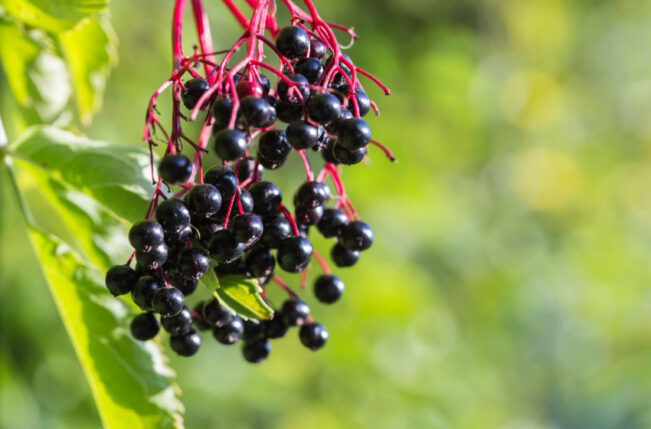Elderberry Quality: Can an Herb be Too Popular?
Elderberry skyrocketed to the top of the herbal market over the last couple of years. As a result it is now a recognizable feature in numerous new products. This rapid increase in the popularity of an herb can have a downside. We will explain the dangers of this phenomenon, as well as the benefits of elderberry extract, when legitimacy prevails.
Unlike some ingredients we can make in a lab, someone must plant, grow, and harvest herbs in season. When there is a sudden increase in demand, supply can take time to catch up. In the case of elderberry, which is a shrub, harvesting only starts after the second year of growth. Elderberry plants can’t reach full potential for several years.
This delay in supply occasionally motivates shady activities such as adulteration. Unfortunately, the amount of adulterated product in the market is often directly related to an herb’s popularity. Some companies adulterate an extract by including a substitution of another plant. In some cases, a substitution may involve an active, identifiable substance. Elderberry powder from the berry has a characteristic deep red-purple hue. Some products have used powdered black rice to mimic this hue, diluting or replacing the active elderberry component.
Media coverage of adulterated herbal products increases skepticism of all companies that work in the supplement space, even the ethical ones. These news stories rarely delve into ways a consumer can find and identify a high-quality product.
Reading a back label is a great start. Supplement facts will at least tell you if the product contains an effective amount, versus a sprinkle so its name can include “elderberry”. And, look for companies who utilize testing methods to ensure their supply of herb is what it claims to be.
Testing for Identity:
The first type of testing involves identifying the plant material. This is more complicated than it sounds as herbs have multiple biochemical constituents some of which may vary from year to year or from location to location as a response to growing conditions as well as related species that may in part resemble the desired herb. However, especially for a well-established herb like elderberry, there are reliable laboratories that can identify the unique fingerprint of elderberry and expose adulterations such as the black rice substitution. Metabolic Maintenance works with top labs in the botanical space that specialize in such testing.
Testing for Potency:
A separate test is an assay to test for potency. An herb must not only be identifiable, but also its abundance must be quatifiable in the product. For instance, suppliers of our high-quality elderberry extract is standardize to a level of 15% anthocyanins. These are the flavonoids that offer immune-supportive and antioxidant properties. Active constituents can wane over time, so a potency test can also give information about a stale inactive herb. Even when it is the right herb. Metabolic Maintenance sends both raw ingredients as well as our final products to third-party testing labs. They verify potency and make sure label claims are correct.
A Word About Sourcing:
While testing via third-party labs provides us with good information about the quality of our ingredients we do want to give credit to the high-quality ingredient suppliers we have built relationships with throughout our nearly 40 years in business. Our quality team is rigorous in assessing our potential suppliers. This has resulted in us working with suppliers who also conduct their own testing, have transparency into their procurement and ingredient handling, and provide us with research regarding their specific offerings.
What is elderberry’s history as a medicinal herb?
The name of the plant, Sambucas, dates back to Greco-Roman times (approximately 350 B.C.E.), and various medicinal uses were described by Hippocrates [1]. In 1644 a 230-page book was written on medical uses for the elder tree, The Anatomy of the Elder Tree, by Martin Blockwich [1].
When colonists observed the indigenous people of the “New World”, they recorded that elderberries were being used both medicinally and as a dye for baskets [1]. Colonial cookbooks contain recipes for foods rich in this deep purple berry to support immune health such as elderberry jam or vinegar [1].
What does modern science indicate about the health benefits of elderberry?
Scientific research has been able to credit some of elderberry’s immune supportive effects to a specific type of antioxidant found in elderberries: anthocyanins (or more specifically cyanidin 3-glucoside and cyanidin 3- sambubioside) [5]. Clinical trials have shown that elderberry supplementation is associated with strong upper respiratory health [8,9].
In addition, anthocyanins (found in elderberries, but also other dark purple-colored fruits such as grapes and currants) have been shown in laboratory and clinical studies to support normal blood sugar, healthy weight management, normal inflammatory responses, and a healthy cardiovascular system [6]. While the bioavailability of anthocyanins from certain foods and wine has been questioned, oral supplementation of elderberry is associated with increased levels of anthocyanins in blood plasma [7].
When/how should I take elderberry extract?
Elderberry extract is an herbal that works as either as a stand-alone supplement or as an ingredient in an immune formula, such as Acute Immune Boost from Metabolic Maintenance. Missed sleep, stress, and nutritional insufficiencies are all things that can negatively affect immune function. This product is for those times you want rapid support for your immune system with nutrients and botanicals chosen to quickly nourish the vital pathways of an effective immune response.
For a daily dose of beneficial polyphenols, look to our newest full-spectrum multivitamin, Balanced ResponseTM, enhanced with both elderberry and ashwagandha to support both stress response and immune health.
Both products include our high-quality, excipient-free elderberry extract sourced from Italy with a potent 15% anthocyanin content.
References
- https://www.herbsociety.org/file_download/inline/a54e481a-e368-4414-af68-2e3d42bc0bec#:~:text=The%20story%20of%20Sambucus%2C%20elderberry,26).
- https://onlinelibrary.wiley.com/doi/abs/10.1002/ptr.5782
- https://www.actahort.org/books/1061/1061_12.htm
- https://www.jstage.jst.go.jp/article/bbb/76/9/76_120112/_article/-char/ja/
- https://www.tandfonline.com/doi/abs/10.1080/07391102.2017.1413422
- https://www.tandfonline.com/doi/full/10.1080/16546628.2017.1361779
- https://pubs.acs.org/doi/abs/10.1021/acs.jafc.0c07771
- https://link.springer.com/article/10.1007/s11606-020-06170-w
- https://www.mdpi.com/2072-6643/8/4/182
